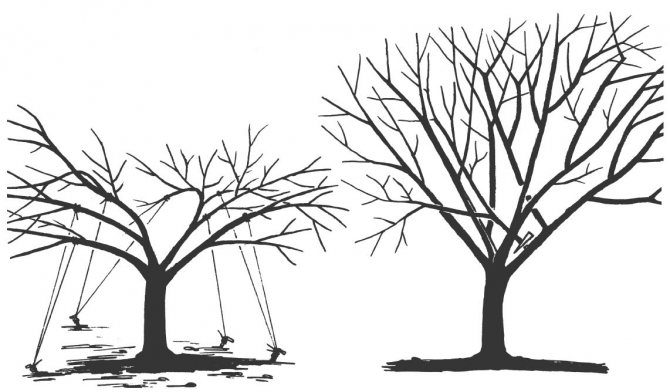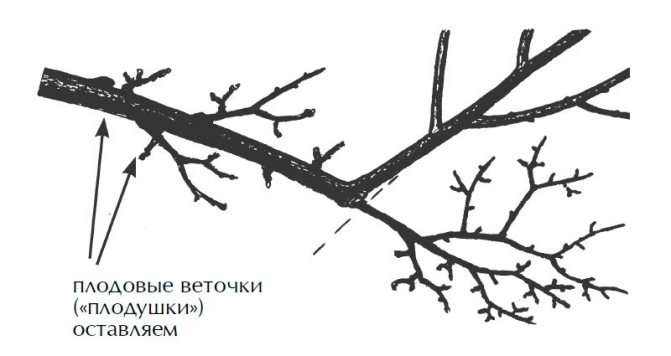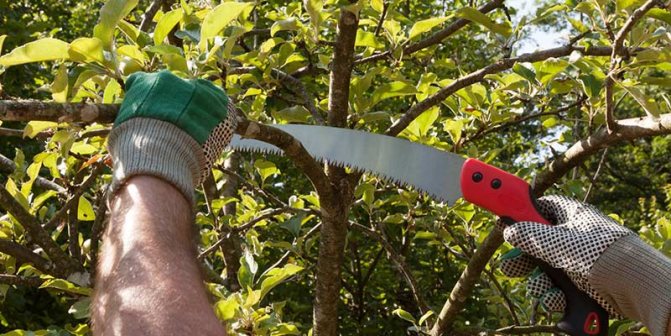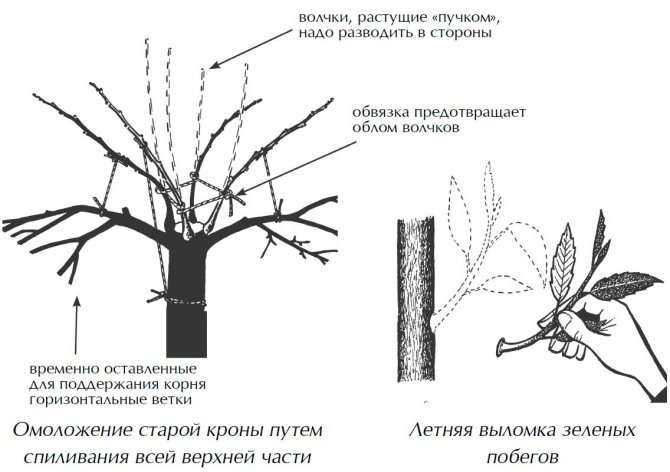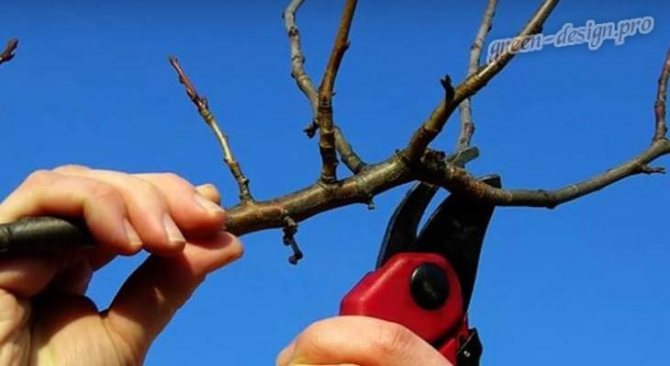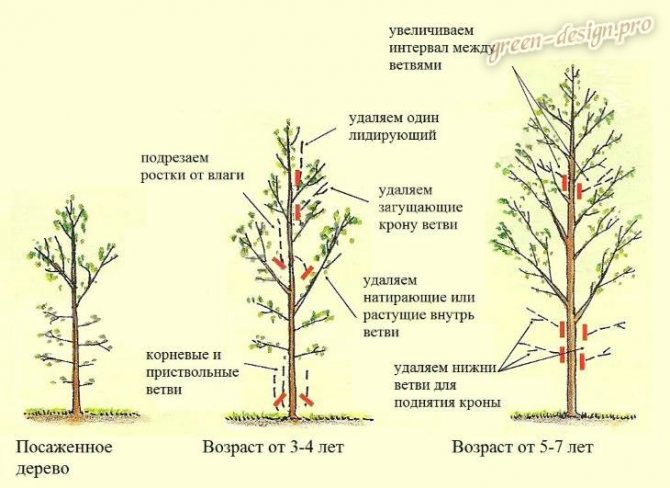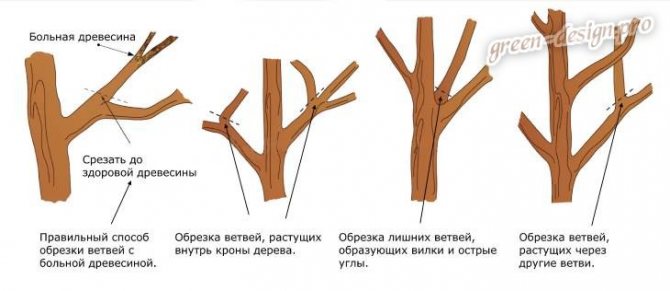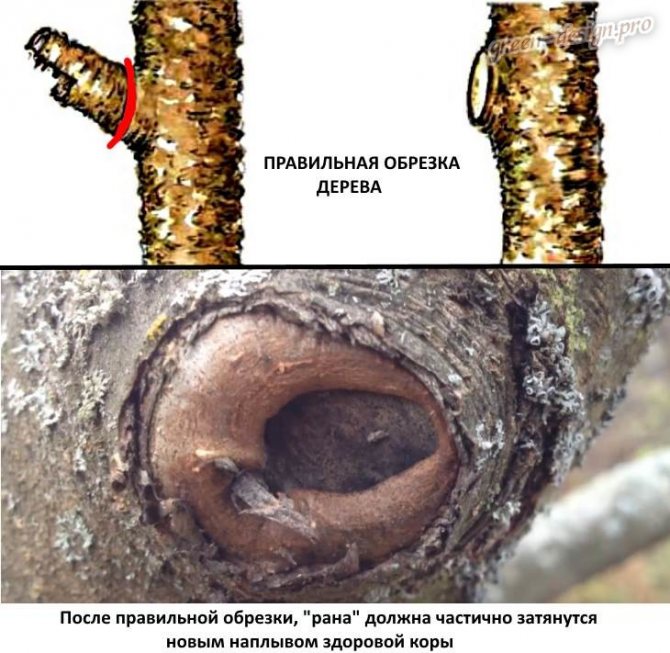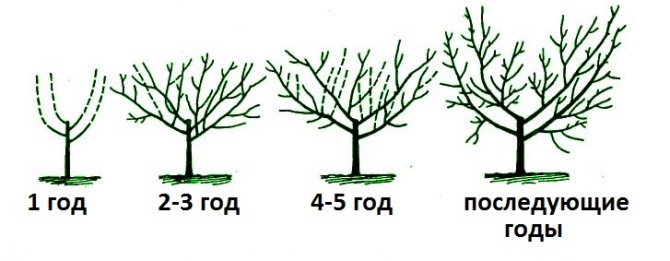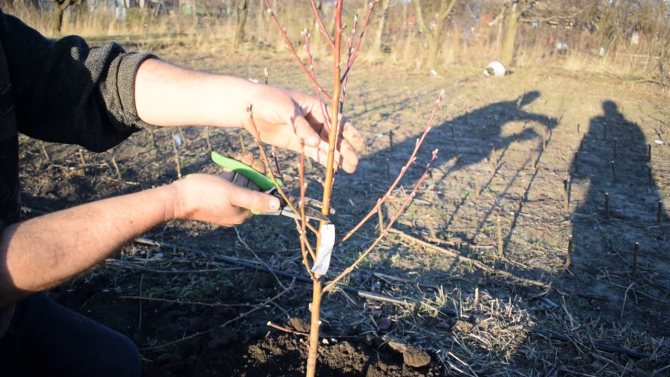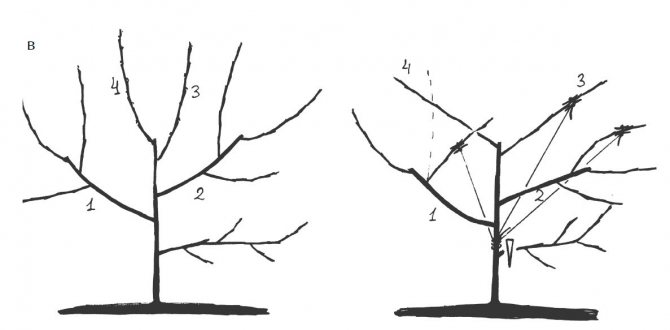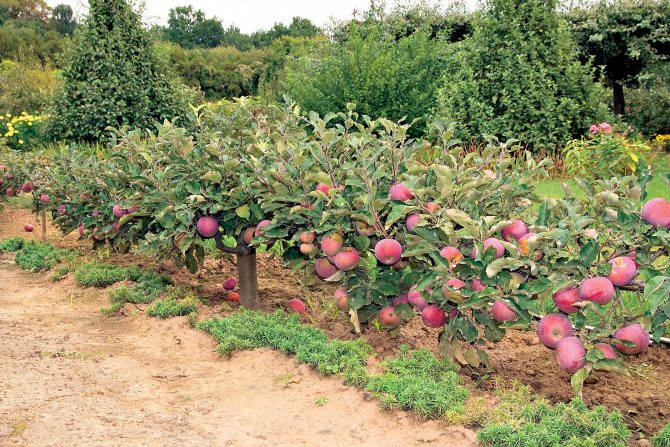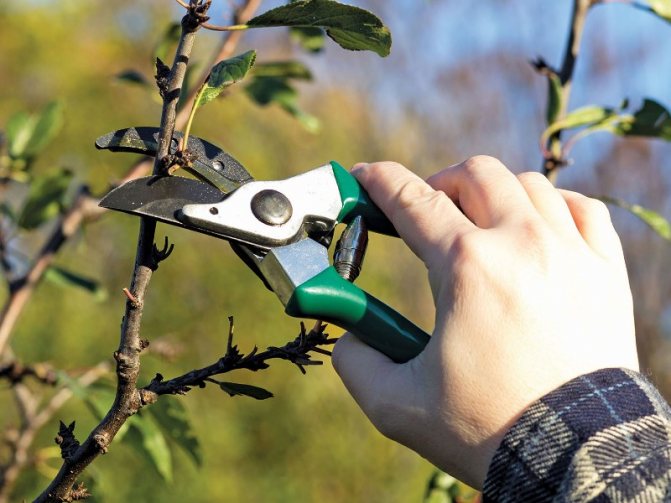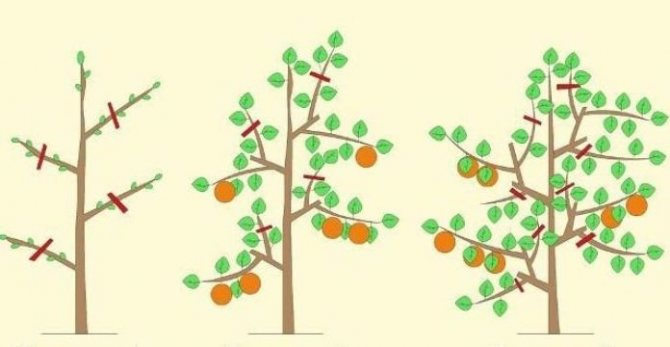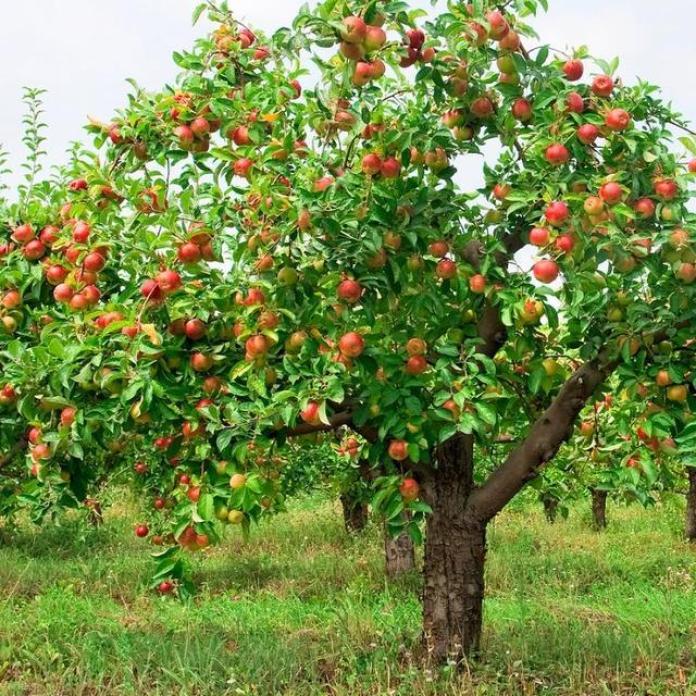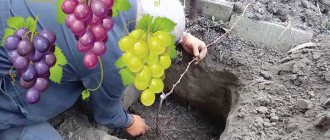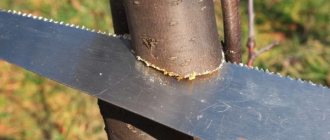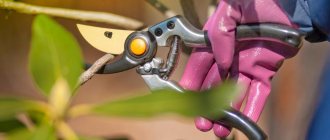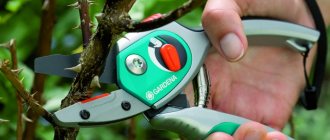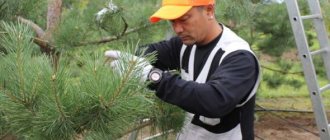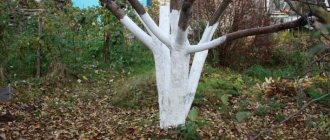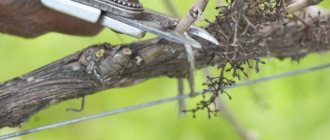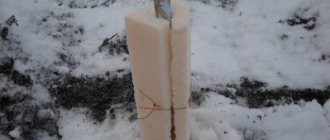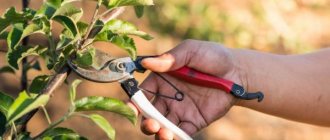The deadline for pruning trees is approaching - in the spring, the apple and pear tree must be pruned before the start of sap flow and awakening of the buds, while there is still snow. What is the correct pruning of trees? Is a pruner and saw enough for spring pruning? How to prune young and old trees? By Pavel Trannoy, author of The Big Book of Gardens and Vegetables.
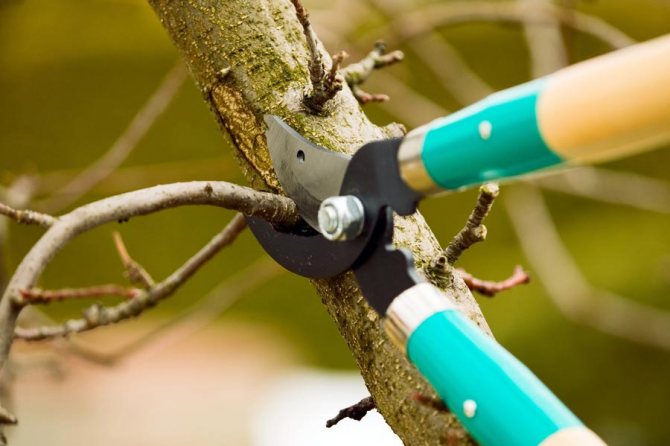
Before we talk about pruning fruit trees, I want to say a few words about caution and injury. It is rare for a gardener to think about safety when handling a ladder during his enthusiastic work. Therefore, a rare gardener in his life never flew down a ladder ... Learn the climber's rule and bring it to automatism: at a height you should always have three fulcrum points. Not two. This means that, in addition to your legs, one of your hands should always hold on tightly to something solid.
How to prune an apple tree correctly?
Before pruning the apple tree correctly, it is necessary to carefully study the methods of pruning and their types.
Types of pruning
Pruning can be formative, sanitary, rejuvenating and regulating. Formative pruning creates a solid skeleton for the tree, on which only strong, fruiting branches remain. Sanitary pruning is designed to remove damaged or malformed branches from the tree.
Rejuvenation - removal of old fruit branches. Via regulatory trim the height of the apple tree is held back, the crown is thinned out, fruiting is regulated.
By intensity, trimming methods are divided into pinch, weak, medium and strong.
- Pinching is used with the active development of annual green growths.
- Low pruning on young trees stimulates the growth of new shoots, skeletal branches are pruned by one quarter.
- With medium pruning, the branches are pruned one third... This method is used on mature apple trees that are more than five years old.
- Heavy pruning involves removing a large number of branches completely. This is how the crowns of mature trees are thinned out.
Basic techniques
Trim to ring
This technique is used when you want to completely delete a branch. At the point of growth, each branch has a ring-shaped outgrowth.
In this place, tissue cells are able to actively divide, so a cut made on a ring heals quickly. It is important to make an even, clean cut.so that about half of the ring remains on the branch and half on the base.
You cannot cut too far from the base - a stump will remain. The consequence of such pruning is that the stump will dry out, fall out and form a hollow. You cannot completely cut off the ring from the base, going deeper into the cambium - this will injure the tree.


Kidney pruning
With partial removal of branches, pruning on an external bud allows you to expand the crown, reduce the degree of its density.
A cut on the bud, looking inside the crown, is used to shoots began to grow inward and the crown became dense.
The correct cutting distance is no more than 50mm from the selected kidney. To exceed this distance - a stump will remain, to underestimate - there is a possibility of kidney damage.
Slices should be immediately cover with garden varnish, oil paint or drying oil, so that the wound does not damage the infection.


An example of the correct pruning for the kidney.
Large circular areas it is better to pre-disinfect with antifungal drugs, for example, a solution of copper sulfate or iron sulfate (three or five%, respectively).
Pruning trees for beginners - the feminine way
About the first one. In gardening, as elsewhere, the psychological side of the issue is no less important than the techniques themselves. The overwhelming majority of the students are women. This is a completely different "brain hemisphere" than the male one - it is saving, not denying. These are not nice words and not an empty phrase, but real nature that biologists should know (plant breeder - biologist or techie?).
It is much more difficult for a woman to carry out decisive pruning of a tree than it is for a man. She is much more comfortable psychologically "sparing option": instead of cutting off branches - tilting them to inhibit growth.
Regarding the second. Every living creature has a "hit area" limit. There is a subtle mechanism in nature: if an individual feels that it is being damaged too much, then it self-destructs in the interests of the entire species. With this, everything is strict, animals and plants in this regard are much more conscious than humans. Therefore, shredding a tree without any measure is fraught with infection and drying out.
In addition, not all stumps are completely overgrown. Slices “on the ring” are well overgrown, ie. where you remove a thinner branch with a thicker one next to the characteristic ring bark ridge: the ridge quickly tightens such a cut. If you cut off a thick branch, leaving a thinner one, then there is no ring bark flow there, the saw cut will overgrow for many years.


Cutting branches is done so that the wound then overgrows more easily: a) when cutting down a thinner branch with a thicker one, it is most correct to cut it "into a ring", along the influx of bark near the branch, then the wound will be surrounded by a ring of rapidly dividing cells and will soon heal; b) when cutting down a thicker branch with a thinner one, there is no such influx, so the cut is carried out so as not to leave a bulging stump
And if the stump is thick, more than 5–7 cm, especially if it was an old trunk, then it will not heal at all, sooner or later it will turn into a hollow. Thick cuts of the trunk do not overgrow. All we can do in this case is to carefully preserve the cut for a long time with garden varnish, allowing a new trunk to develop from the side, which the hollow will not harm in the future.
You need to have a firm idea that in a fruit tree, the roots and branches always strive to correspond to each other, they are always in balance. If you remove too many branches, the root will be disproportionately large. On the one hand, it will begin to strongly influence the rapid growth of young shoots, on the other hand, it will remain without nutrition and at the same time will begin to die off in some parts. Naturally, fruiting will be delayed, although the tree, of course, will recover later.
Thus, the leaves are hard workers, providing carbohydrates for the roots and the apples themselves. The leaf apparatus must be protected, the branches must be cut off carefully.
Terms of work
Timing of pruning is determined by the needs of the trees, not the grower. The best time for work is the very beginning of sap flow. Pruning of trees begins in the spring from mid-April and continues until the buds dissolve..
Advice! In early summer, it is convenient to carry out sanitary pruning, since it becomes clearly visible which shoot survived the winter and which is frozen.
During this period, it is easy to identify branches infected with infection or pests. In August, pruning can be done in areas where spring return frosts are common. This will slow down the beginning of the growing season of the tree for the next season, will preserve the fruit buds.
A good time to prune apple trees is autumn, when the leaves and fruits have already been dropped. The main thing that the next two to three weeks, the air temperature did not drop below ten degrees... In the south, in climates with warm winters, the pruning period can last until February.
Based on the timing of work, methods and types of pruning, you can draw up work schemes in different seasons.
Apple tree pruning scheme for beginners
How to properly prune apple tree branches in spring?
In the spring the main tasks of the gardener - elimination of the consequences of wintering apple trees, their preparation for the new season. Sanitary pruning is carried out, young apple trees form:
- All broken, burnt and frostbitten branches are removed;
- Branches heavily damaged by infections or pests are completely destroyed;
- Branches growing inside the crown and forming an acute angle with the trunk are removed;
- Old trees can be rejuvenated;
- Strong or medium adjusting pruning is done if necessary.
By performing regulatory pruning in the spring, you can control the amount of your crop. If the tree had a large harvest the previous year, it has laid some flower buds. Spring regulating pruning is not needed in this case.
If the previous year was not rich in harvest, then in the spring the tree should be cut hard enough... So on the apple tree there will be as many fruits as it can grow without spending excessive efforts.
How to prune apple trees in summer?
Cardinal pruning is possible only as a reaction to negative natural phenomena.
- Early summer - time to remove diseased branches, if the extent of their damage was not visible in the spring;
- End of June - pinch the rapidly growing green shoots so that they do not take food from the main skeleton of the plant, do not shade the crown;
- Anytime those branches are cut that have broken or cracked under the influence of natural factors or the severity of the crop;
- The end of the summer - old branches of adult plants are removed, on which few apples have formed and those that shade young fruiting branches;
- The end of the summer - make pruning of fruiting trees in order to slow down the beginning of the growing season in the next season, if necessary.
If there are no sick and broken branches on the apple trees, in the summer you can limit yourself to only those pruning that regulates the density of the crown. Knowing how to prune an apple tree during the summer months will help you achieve a successful harvest.
How to prune apple trees in the fall?
In late autumn, you can carry out all those pruning work for which there was not enough time in spring and summer:
- Branches broken by the wind are removed;
- Branches that have broken or cracked under the weight of the fruit are removed;
- After fruiting, sanitary pruning is carried out to get rid of the consequences of harvesting;
- Anti-aging pruning of old apple trees is carried out;
- If, during the fruiting period, branches were seen on adult apple trees, on which there was practically no harvest, they should be removed;
- Branches on which small and deformed fruits have grown are removed;
- Branches that obscure the main fruiting shoots are removed;
- Branches heavily affected by pests, bacterial or fungal infections are removed.
Advice! There is no universal pruning scheme, focus on the individual needs of each apple tree.
The need for pruning depends on many factors. One of them is the age of the orchard.
Sanitary pruning
Sanitary pruning aims to remove unnecessary, dangerous twigs and twigs. It is carried out after natural disasters, outbreaks of disease, removal of infected shoots and branches. Such branches at the time of pruning should be cut to the fruit ring. When removing diseased knots, a part of healthy tissue is cut off. How useful Lobo apples are in this article.
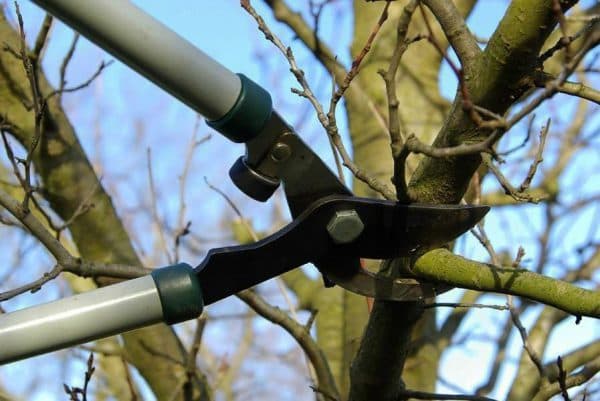

If the branches are badly broken, only the damaged part should be removed.
Spring sanitary pruning is carried out after cold winters or the end of returnable spring colds. You need to cut out every frozen branch - right down to healthy tissue. All excess material is burned.
It is imperative to cut off healthy areas with diseased ones - this will prevent rotting of the plant in the future.
How to cut apple trees of different ages correctly?
Having decided to cut a young apple tree, the gardener aims to lay a good foundation for its further development. An old fruit tree is pruned to enhance fruiting, remove crown defects, and save vitality for further growth. Most of the work associated with pruning adult apple trees is aimed at getting rid of diseases and pests.
Although the methods and types of work for pruning young and adult trees are the same, the work technology is different. Let's consider further how to prune an apple tree by year.
Annual apple tree
The gardener at this stage has two tasks: to restrain the growth of the central shoot so that the skeletal side branches develop well, and to form a stem. Formative pruning of young apple trees should begin one year after landing.
At the age of one year, the seedling consists of a trunk and 2 - 3 branches. If the central trunk is cut at a height of 0.8 - 1 meter, the growth of lateral shoots will increase. Long skeletal branches should be shortened. Each of them should be 16-20 cm shorter than the height of the trunk, have from three to five buds.
To form the correct stem, shoots that grow on a seedling at a distance of 40-50 cm from the ground must be removed. Branches that have an angle of up to 60 degrees at the point of growth will not be able to form a good backbone on their own. You can deal with them in two ways: remove or try to give them a horizontal position.
Biennial apple tree
If you are thinking about how to cut a 2-year-old apple tree, then you should know that pruning helps to lay the tiers of skeletal branches correctly.
The shape of the crown - any, except for the cupped one, assumes the presence of two to five large branches on each tier. The interval between the formed levels is approximately 40 - 60 cm and depends on the expected height of the tree.
The branches of each level should be located at approximately equal distance from each other relative to the circumference of the level. For a two-year-old seedling, the skeletal branches are shortened.
If a decision is made to form an apple tree in the form of a bowl, then in the second year of life the seedling completely remove the central trunk... The cut is made over the first fork of the branches.
In the absence of a center, the side branches will take over its role. An apple tree will be formed, consisting of 2-4 trunks, depending on the number of skeletal branches on the first tier.
Until the age of five, the crown continues to form.
Adult apple tree
From the age of five, rejuvenating is the main pruning that is carried out on fruit trees. Before starting it, make sanitary pruning.... When the apple tree is cleaned, they begin to rejuvenate:
- Cut off all old branches that are no longer capable of producing apples of varietal size and quality;
- Part of the tops is cut out;
- Crossed branches are cut onto the ring;
- All branches directed inside the crown and downward are removed;
- The root and shoots growing at the trunk are destroyed;
The last stage of anti-aging procedures is the shortening of the trunk. Tall trees can be pruned up to 3.5 - 2.5 meters without damaging the intensity of fruiting. Removing the apex gives light access to the inside of the crown, helps to increase the quality of fruits and their quantity.
Important! If the apple tree is more than eight years old, you cannot do anti-aging pruning at one time. Losing a large amount of vegetative mass at the same time is a big stress for the old tree... It is better to spread the work over several years.
The pruning of apple trees on dwarf and columnar rootstocks has its own peculiarities.
What means are used to process the cut sites


Branches, the cut diameter of which reaches 1 cm or more, must be treated with special means so that an infection does not get into the wound, and healing is faster.These can be store-bought formulations and putties made at home.
Garden vars
This group includes products made on the basis of beeswax, propolis, rosin and alcohol. Garden var is a kind of putty for treating wounds, including those resulting from tree pruning.
Most often, this product is sold in solid form, it will have to be melted before use. This can be done in a water bath or simply by leaving the product under the rays of the sun until softened.
Before applying the var, the cut is disinfected with brilliant green or a solution of copper sulfate. After that, putty is applied in a thin, even layer, without gaps. At the end of the procedure, experts recommend tying the treated area with a breathable cloth. The garden pitch is inexpensive. Depending on the manufacturer, the price per package is from 40 to 100 rubles. The product is also available in the form of an aerosol, which is significantly more expensive.
Putty recipes
In addition to garden varnish, other means can be used to treat wounds on fruit trees. Often summer residents use:
- Oil or emulsion paint. These products work well for sealing wounds and protect the cut from moisture and harmful bacteria. However, paint can be washed off by rain. From time to time they will have to be applied again.
- A mixture of clay. To prepare such a putty, you need to mix 2 parts of clay, 1 part of cow dung and a little chopped straw or hay. After combining the components, the mixture should resemble sour cream in consistency.
- Cement putty. 3 parts of fine sand are added to 1 part of cement and diluted with water to the desired consistency. For elasticity, you can add a little drying oil to the putty.
On a note! If none of the above is at your fingertips, you can cover the cut with ordinary garden soil by rubbing it well into the wound. This is exactly what our ancestors once did.
How to prune a dwarf apple tree?
On a dwarf rootstock, apple trees give abundant yields, they begin to bear fruit earlier. If you do not cut dwarf fruit trees, their total fruiting period can be reduced to 3 - 5 years.
In the first year of life, the skeleton of the crown is formed by trimming the trunk. The cut height depends on the variety and is 40-70 cm.Lateral shoots are pruned so that the crown visually becomes similar to ball, cap or triangle.
The closer to the top of the apple tree, the more the branches develop. Strong upper branches shorten, which stimulates the growth and development of shoots in the center of the crown. Branches of trees on dwarf rootstocks, if they are healthy, rarely cut completely... Most often, two to four kidneys are left on them.
As soon as the apple tree begins to bear fruit, the number of flower buds should be regulated so as not to overload the apple tree with fruits. Under the weight of the fruit, dwarf varieties can be threatened not only with a fracture of the branches. A tree can uproot itself from the ground.
find outwhat kind of care your apple trees need in spring, summer and autumn. And remember that proper care is the key to a successful harvest!
What should you do if you don't have a chainsaw?
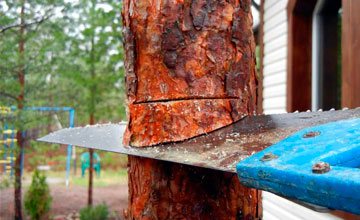

The chainsaw is the most efficient tool for cutting any tree.
If not, you can use an ax and a hacksaw or a two-handed saw.
To make a cut with a hacksaw cut the trunk across the grain by 1/3 of the trunk diameter.
It is advisable to use a hacksaw with the largest and sharpest teeth possible.
Then with an ax, they cut wood at an angle of 45 degreesby striking 2–4 cm above the cut. After that, the trunk is cut from the other side 3-5 cm higher (depending on the diameter - the thicker the trunk, the greater the difference).
If there is neither a hacksaw nor a two-handed saw, then all operations are performed using an ax - first, they strike along the cutting line, deepening the blade into the wood by 1–2 cm, then chop from above at an angle of 45 degrees, forming a notch.
Some craftsmen do the opposite, first striking at an angle, then chopping perpendicularly. Both methods are the same in terms of effectiveness, so you can do what is more convenient in a given situation.
Finished with him in the same way, wood is cut down on the other side, however, the upper cutting line must be 10–15 cm higher than the lower one, otherwise the tree may start to fall in the wrong direction.
If at least part of the work is performed with an ax, then it is necessary to fix the trunk with at least a rope under an interference fit, and it is better to use a winch and springs. If this is not done, then the tree may fall in the other direction.
Moreover, with an ax and a hacksaw or two-handed saw not worth chopping trees, whose diameter exceeds 10 cm... Their barrel is too heavy, therefore, due to strong blows, it can go in the wrong direction and seriously injure. Also, you cannot chop down rotten and rotten trees with an ax; branches can break off from blows and hit hard.
How to properly prune a columnar apple tree
The crown shape of columnar apple trees is special. The width of such a tree does not exceed 50 cm, it has no long lateral branches. Regular trimming of the columns is not required. But sometimes the apple tree needs pruning.
Damage to the top of the trunk
Apex damage - one of the most common problems columnar apple tree. The damage is usually caused by frost and pests, then by the beginning of the season the apical part of the trunk dries up and dies off. These processes force the growers to trim the tops.
The peculiarity of pruning shoots at the crown is that it is necessary not only to cut off the central shoot, but also to find a replacement for it. If this is not done, the apple tree forms several trunks at the top, will lose its column shape... To create a new crown, the strongest shoot is chosen, which grows vertically.
The remaining vertical branches are cut off, leaving two to three buds from the base. The former crown is removed at the point of contact with the chosen leader. To avoid the need for trimming, the tops of the columns should be wrapped for the winter.
How to trim an apple tree while maintaining its crown shape?
The first year of growth, columnar varieties, as a rule, do not require the intervention of the gardener in the process of crown formation. Starting from the age of two, young growths begin to compete with fruiting branches, take food from them.
It is during this period that the gardener must intervene and adjust the ratio of the growth of the main branches and increments:
- All the shoots that the apple tree has formed are pinched at the same distance from the trunk, which is 25-30 cm;
- On the third, and the following years, the pinching is carried out at a distance of 30-40 cm;
- Starting from the fourth year, three-year branches are partially removed.
The peculiarities of pruning lateral shoots are that with systematic pinching, the columnar apple tree will not need pruning. Since pinching is a more gentle procedure, the apple tree is not injured, does not experience stress.
Attention! It is recommended to completely wrap the columnar apple trees with covering material in several layers for the winter. So, during the period of severe frosts and sharp fluctuations in temperature, flower buds, trunk and, most importantly, apple tree bark will not suffer.
Any apple tree after the pruning procedure needs special supportive care.
Related Videos
We have prepared several videos that show you how to remove trees by hand correctly. The first video will help you figure out how to cut a tree with a chainsaw, knocking it down in the right direction:
The following video will also show you how to properly and safely cut wood with a chainsaw and a felling shovel:
The third shows how a guyed tree is removed:
The author of the following video tells how to cut trees growing along wires, fences and other hard-to-reach areas:
We also prepared a video showing how not to do it, and what can happen if you cut it incorrectly trees.
The first of them is a selection from all over the world of unsuccessful attempts to cut and fell trees, which led to various kinds of troubles:
The second video in this series is also examples of accidents. They remind us once again that cutting down trees is a serious job that requires the strictest safety precautions and attention to even the smallest detail.
Violations, negligence and inaccurate assessment of the situation can lead to serious consequences:
Apple tree care after pruning
After pruning, fruit trees need watering and feeding. If the pruning was carried out in the spring, it is necessary to apply fertilizers to the soil of the near-trunk circle, which contain nitrogen, phosphorus and potassium in equal parts.
After the autumn pruning, fertilizers are applied, which contain potassium and phosphorus - they stimulate wound healing, strengthen the bark of the apple tree. Nitrogen fertilizers should be avoided in the fall.
The introduction of nitrogen in the fall will give an impetus to the development of new shoots, as a result, the wood of annual growths will not have time to mature to the end, the apple tree will not prepare for wintering. As a result, the cuts made in the fall may be susceptible to frostbite.
When making top dressing, you should strictly observe the fertilization rates. Over-fertilizing apple trees will do more harm than good.
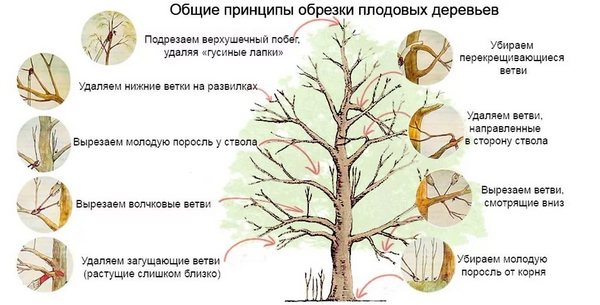

Apple tree pruning scheme.
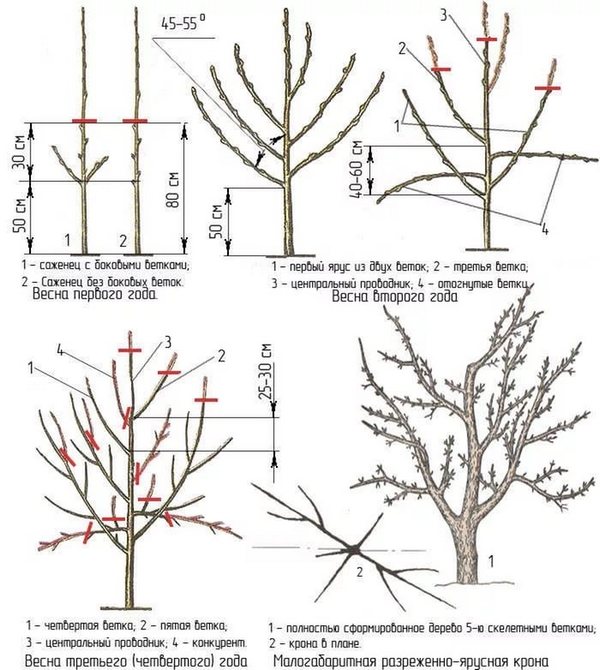

How to prune an apple tree by year.
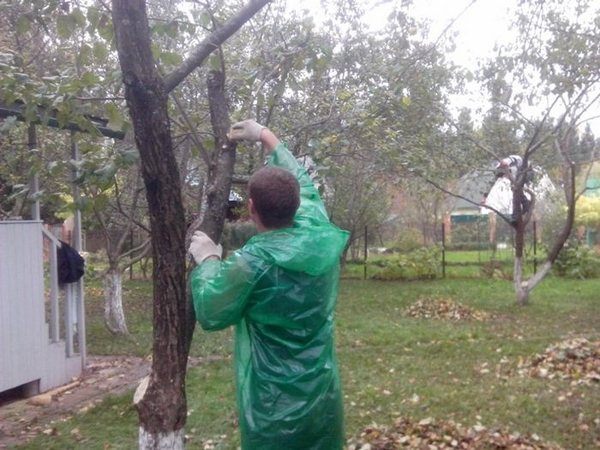

How to prune an apple tree in the fall.
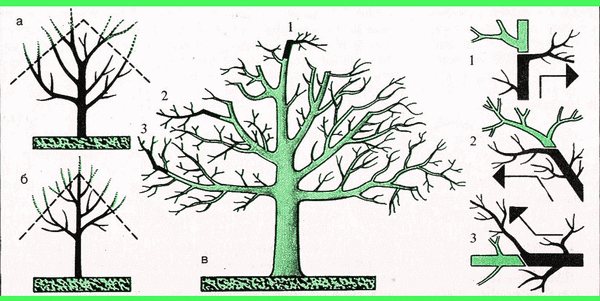

How to prune apple trees to form the crown of a tree.
Why prune fruit trees?
Fruit trees such as apple, pear and stone fruit need pruning. They are very demanding on pruning. Why prune fruit trees?
By pruning, gardeners solve several problems at once:
- Growth and fruiting.
- Reducing the size of the crown.
- The phytosanitary task is to create conditions unfavorable for pests and diseases.
The procedure for pruning trees prolongs their life and leads to a rich harvest.
If little light enters the crown, then the branches inside the crown do not bear fruit and eventually die off. Fruits are formed only on those branches of the tree where light hits.
AND if the tree was trimmed rarely or not at all, then the fruits will be on hard-to-reach branches, usually located high.
Thanks to the trimming procedure the crown of the tree is formed correctly... This leads to the growth of side branches and allows you to get more fruit on the available branches.
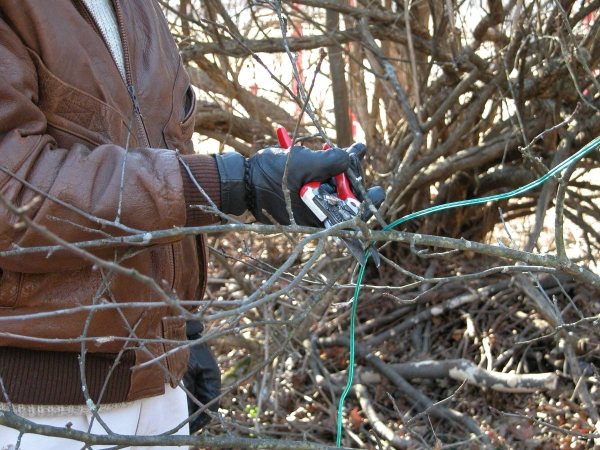

Thanks to the pruning procedure, the crown of the tree is formed correctly, leading to a rich harvest

